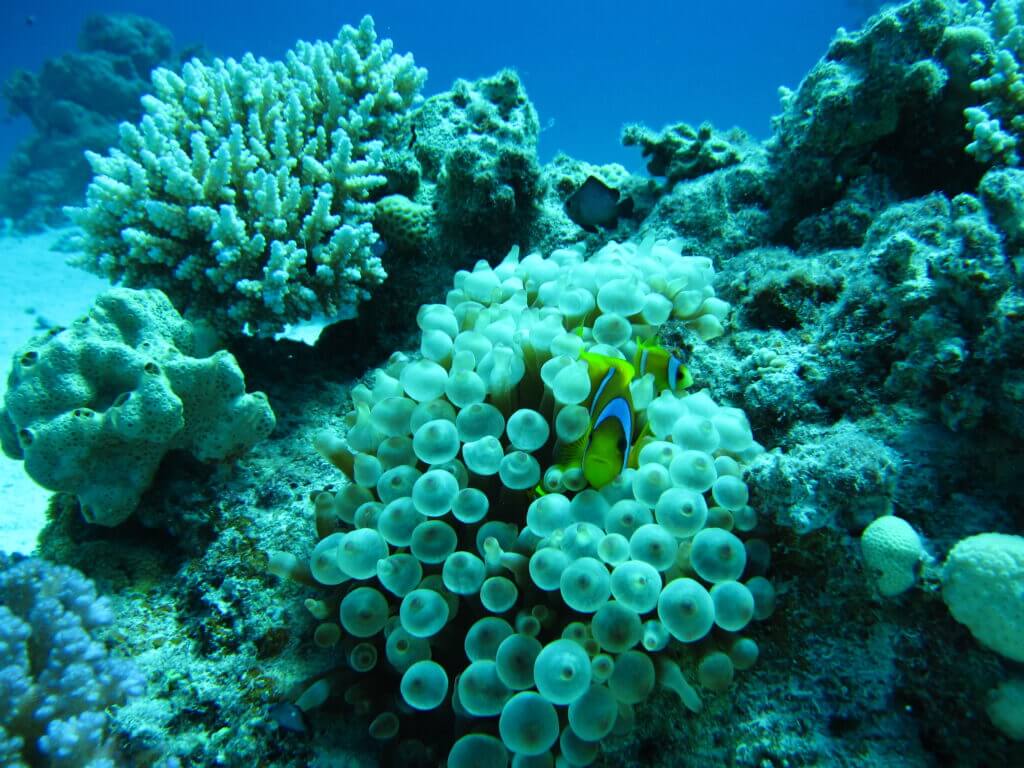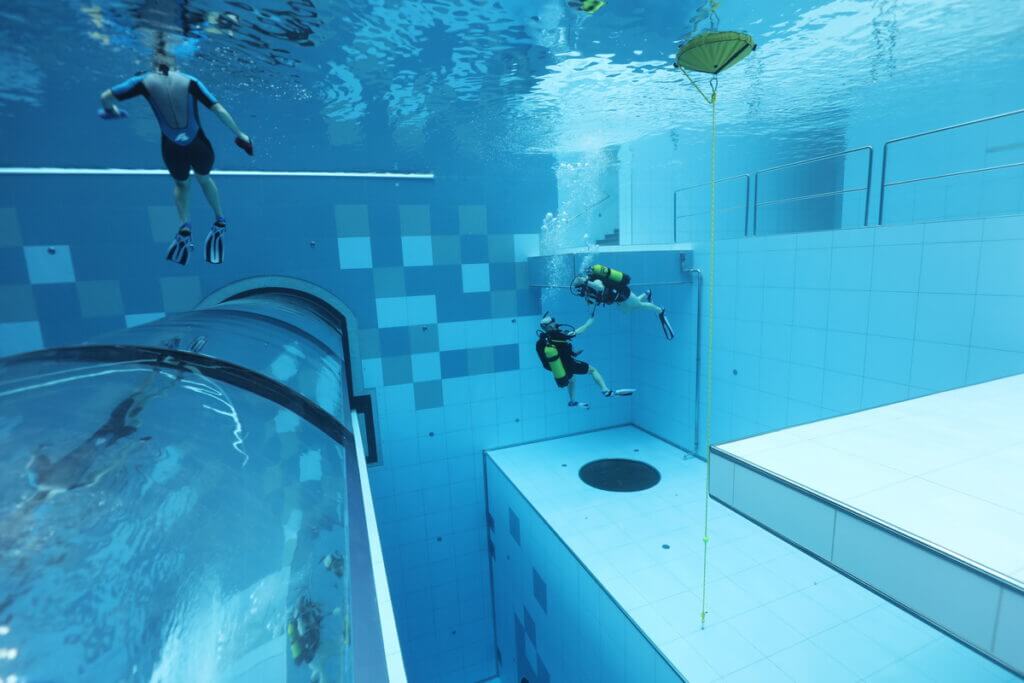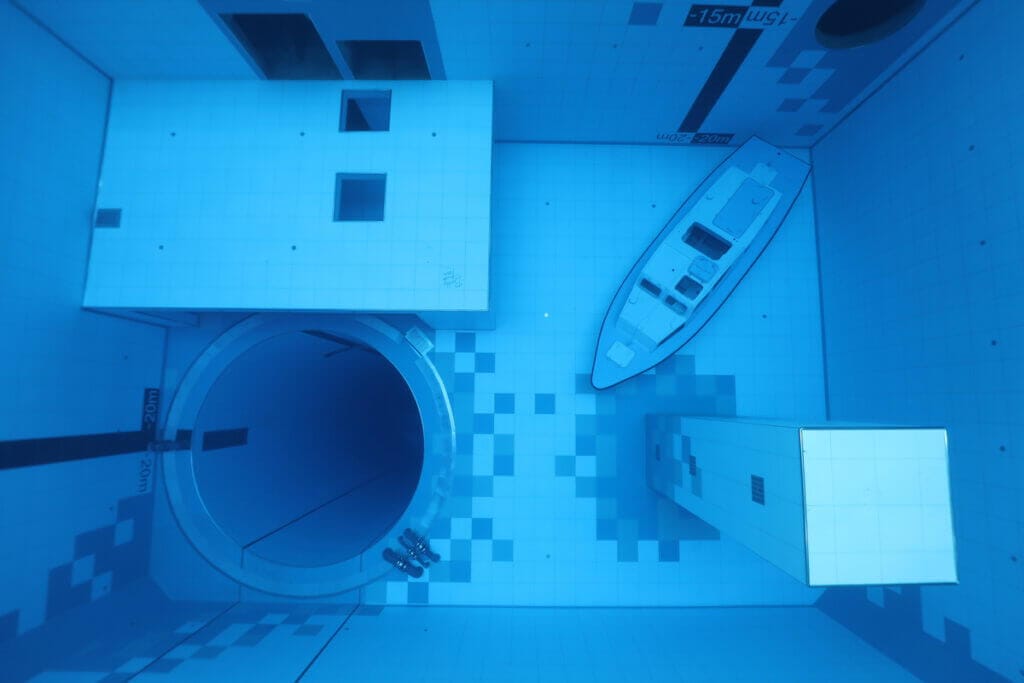When we dive in clear southern seas, the water clarity often reaches up to 30 meters. This means that from 30 meters you can see the surface, but it is very rare to see the bottom at 30 meters from the surface. Sometimes in really clear water such as in the southern Red Sea you can see the bottom at 30 meters, but such visibility is quite rare. However, getting something similar in a pool is a huge challenge and getting even better parameters, such that you can see the bottom from the surface at 45 meters, is a really good result.
Deepspot in Mszczonów near Warsaw is a truly remarkable pool, 45 meters deep is something amazing, as is the 45 meter transparency.

Size of Deespot
Such a huge swimming pool, on top of that with a rather complicated design, poses great challenges in terms of maintaining cleanliness and especially water clarity. Deepspot, contains 8,000 m3 or as much as 10 swimming pools, so there is plenty to clean and filter. On top of that, the construction of underwater walls with a varied course makes for quite complex surfaces to be cleaned.

High water temperature vs. water purity
As an added complication to keeping the microflora in check, the water temperature is higher than in typical pools, at 32 degrees. The warmer the water, the more readily not only bacteria and fungi but also algae thrive. Every contaminant that enters the water can become a new outbreak spreading microorganisms, which are then hard to neutralize. That’s why strict restrictions are placed on the rules for using your own equipment at these types of pools. Simply put, algae (and other microorganisms) will be carried on diving equipment used for diving in other, not so clean places and then it is very difficult to remove them. Treating pool water involves more than just filtering it. The walls of the pool must be physically washed by divers on a regular basis and while the sediment adhering to the walls washes off fairly easily, removing algae is much more difficult.

Water filtration
Deepspot has a powerful system of modern filters based on silica earth. With a capacity of about 500 liters per second, all of Deepspot’s water passes through the filters four times a day. On top of that, the “topping up” of fresh water will replenish the one that the pool loses due to evaporation. Maintaining a surface temperature of about 34 degrees and only 55% humidity provides good conditions for divers but also causes some losses. Per day, 40 m3 of water is added to the system. The water, as in any pool, has some chlorine added and a neutral acidity (7pH) is maintained.
Deepspot’s walls are washed underwater every other day by divers from a specialized company. Simply getting rid of sediment and algae requires cleaning tiles and literally every grout.
However, keeping the water clean from the point of view of sanitary surveys or safety for divers is not a problem. The problem is maintaining water clarity. Surely many of us have swum underwater in a pool at some point. Rarely at any pool, you can perfectly see the pool wall at a distance of 25 meters and at 50 meter pools, the view of the second wall is even rarer. Deepspot has over 50 meters of water clarity.

Keeping Deepspot water clean vs. the problem of using your own equipment.
It is from the desire to maintain such transparency that certain restrictions arise, which we as divers should understand. The first thing is to really wash ourselves decently with soap before getting into the water to wash off the sweat and certain amounts of bacteria we have on our skin. However, here I would like to say more about the second restriction, namely the prohibition of the use of own jackets and foams. As for the marshmallows, there is actually no problem because at 32 degrees water temperature they are not needed. Doubts are raised by some divers about the ban on bringing their equipment. In fact, the ban actually applies only to jackets because automatics and ABCs can be had and foams are not used anyway. The problem with jackets is that some water gets into them when diving. When the jacket later lies in the warmth, algae and other microorganisms taken from open water or another pool thrive inside the bags. Then, after the eventual entry into Deepspot, the contents of the jacket bag or wing will be partially removed into the water and very efficiently “infect” the local environment. If more chlorine- and anti-algae-resistant algae are brought in, they are then hard to eradicate.

Use of Deepspot equipment
Finally, I would like to add that I do not understand a bit the complaint of some of the diving fraternity about the lack of possibility to use their own equipment in Deepspot. Maybe it stems from the fact that I often fly somewhere far away for wandering and diving. I take because of carrying all this equipment and the size of the luggage only a computer and possibly ABC. That’s why I’m used to diving in different equipment. All in all, being able to go to Deepspot with a small bag, towel, bathing suit and computer is an advantage. In other places I wear equipment and in Deepspot I have a trip to lightly.
From conversations with many instructors who train at Deepspot often, the issue of convenience associated with not having to carry, equipment is cited first.
When diving at Deepspot (as at all such pools in the world), we use equipment borrowed at the entrance fee.
Own one you must have:
- Computer (can be borrowed for an additional fee)
You can have your own:
- mask, snorkel, fins
- T-shirt under the equipment – razor or lycra type.
- breathing machine
On site we get in the price of entry:
- 12 and 15 l cylinder or twin
- ballast (mostly not needed because we dive without wetsuits – water is 32 degrees)
- Jackets, wings for singles or twins
- vending machines (if you don’t have your own)
- Mask, snorkel, fins (if you don’t have your own)
- drysuit
As you can see, there is something for every diver. Both a beginner and someone looking for additional experience in more advanced equipment. In fact, regular specialization, divemaster or instructor courses held in Deepspot confirm that virtually any training can be conducted based on Deepspot equipment.












